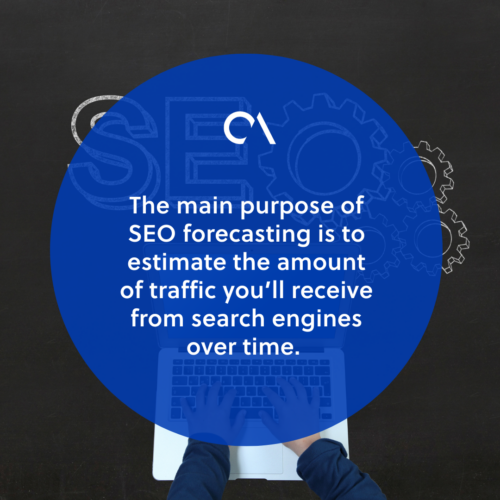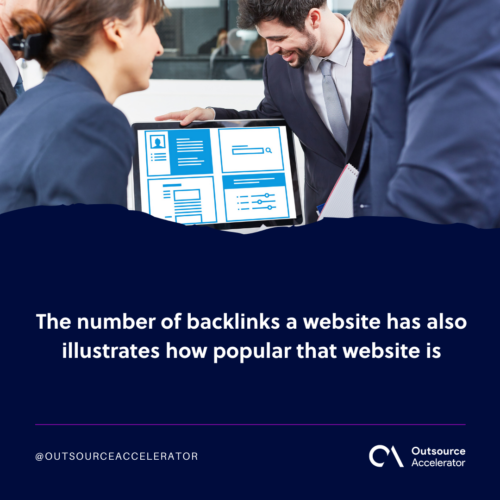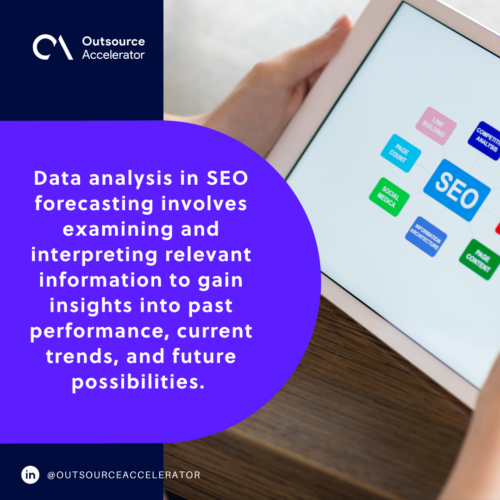A comprehensive guide for effective SEO forecasting

In the ever-evolving world of search engine optimization (SEO), staying ahead of the competition requires more than just optimizing keywords and building quality backlinks.
To truly thrive in the digital landscape, businesses must embrace the power of SEO forecasting.
This strategic approach involves analyzing data, evaluating trends, and making informed projections about future SEO performance.
Harnessing the insights from SEO forecasting lets businesses fine-tune their strategies, allocate resources effectively, and pave the way for long-term success in organic search rankings.
This article delves into SEO forecasting, its significance, key steps, and benefits to help you navigate the SEO landscape and drive sustainable growth for your online presence.
What is SEO forecasting?
Search engine optimization (SEO) forecasting is a method for predicting changes in search engine results. It’s a way for companies to plan around shifts that may affect their search rankings and, consequently, their advertising revenue.
The main purpose of SEO forecasting is to estimate the amount of traffic you’ll receive from search engines over time. This way, you can plan your marketing efforts accordingly.
SEO forecasting operates through machine learning, analyzing current events to predict future traffic.
As one might imagine, SEO forecasting is a complicated task because there are so many variables that could change the rankings of a website or blog. The main reason it’s important is because it allows you to make strategic decisions to maximize your site’s potential.
It’s important to note that SEO forecasting isn’t an exact science. There are no guarantees that it will work for you or your business.
However, it does provide a good indication of how your rankings might change over time and how you can use that data as an asset.

Types of SEO forecasting
Here are a few ways SEO forecasting is conducted:
Keyword tracking
Keyword tracking helps marketers determine how well keywords are performing in their campaigns.
Keyword tracking is an effective SEO forecasting technique to gather information about what people are searching for. You can determine which keywords are most relevant to your business and how often they’re searched for.
It will help you decide whether or not you need to focus more on certain keywords or if you can expand your marketing efforts to meet people’s search needs.
Analytics analysis
Analytics analysis is a common SEO forecasting method. It looks at your site’s past data and traffic and compares it with the current situation. Looking at historical data can give insight into how to forecast the future.
You can also use this information to improve your site’s user experience by making historically popular changes. Several online tools can help you, such as Google Analytics, Moz Analytics, and Semrush.
Competitor research
It’s also important to understand your competitors’ SEO strategies in SEO forecasting. Competitor research involves studying what other websites similar to yours are doing and then using that information to predict the future.
You’ll essentially be using your competitor as a model that you can observe to determine what works and what doesn’t. This will help you make better decisions for your own SEO forecasting and strategy.
For example, imagine one of your competitors has built an organic traffic spike by publishing new content on a specific topic. You can use this specific topic information as an opportunity to predict where your website will be in the next few months.
You can then plan your SEO strategy around topics that may not have been on your radar before.
Metrics to track during SEO forecasting
Keep track of how well your SEO forecasting is going by following these core metrics:
Organic traffic
Organic traffic is a key indicator of your SEO success. It’s the total number of people who visit your website organically, not directed there by other means (like paid ads).
Organic traffic is one of the most important metrics to track when doing SEO forecasting. It indicates how well your content performs and whether you’re reaching your target audience.
The more organic traffic you have, the better. It indicates that people find your site useful and relevant, suggesting they’ll continue returning.
If you’re not seeing an increase in organic traffic, there’s a good chance that you’re not doing enough to improve your rankings.
When measuring organic traffic, look for increases in the following:
- Traffic from search engines
- Traffic from direct traffic
- Traffic from social media
Keyword rankings
Keyword rankings tell you how your website is doing in the search engines and what keywords you should be focusing on.
Keyword rankings are a good metric for SEO forecasting because they reveal fluctuations in search volume. However, it should be noted that this method isn’t perfect. Monitoring keyword rankings doesn’t take into account the quality of the content or the authority of the site.
Aside from being a good indicator for SEO forecasting, keywords can also be used as a benchmark for future success.
Tools like Google Analytics or Ahrefs can track the keywords that bring visitors to your site. For each keyword, you can see:
- How many clicks were generated
- How much traffic it produced
- Its average position on Google’s search results page (SERP)
It also gives you a list of related keywords that brought visitors to your site. You can get ideas for new content topics from this list.
Backlinks
Backlinks are the number of links that point to your site. A higher number of backlinks means that more people are linking to your site, which can help increase traffic and your ranking in search engines.
Backlinks are another key metric to track during SEO forecasting. The number of backlinks your website has can be used to indicate how well you’re ranked in search results.
If you have more backlinks than your competitors, then your rankings will be higher than theirs. This is because search engines, especially Google, rely heavily on backlinks to determine which websites should be listed first for certain keywords.
The number of backlinks a website has also illustrates how popular that website is. If you’re curious about how much traffic a website receives, then a look at its backlink count can help you.
The types of backlinks you want to track include:
- Topical or contextual links. Links from other sites on the same topic as yours. They refer directly to your topic or industry.
- Authority links. These are links from high-quality websites that have good reputations within their niche. They can be extremely beneficial for improving your rankings in Google search results.
- Inbound links from social media sites like Facebook and Twitter. If these sites link to your website, it’s a good indication that people are talking about you online.
Bounce rate
The bounce rate is the percentage of visits that leave your website from the entrance page without navigating to another page.
When users “bounce,” they found what they were looking for on that page or were disappointed with the content and left immediately.
Digital marketing site Siege Media considers 50% as the average bounce rate.
During SEO forecasting, you’ll want to aim for a low bounce rate and ensure that visitors stay on your site. You can get an idea of whether you need to modify your content by comparing bounce rates with competitors.

Using data in SEO forecasting
Data is a key ingredient when it comes to SEO forecasting. This section details how you can use data to maximize your SEO forecasting efforts.
Data collection
The first step in SEO forecasting is data collection. You can do this by using analytics tools to monitor your website traffic.
Another way is to set up goals and conversions on your site so you can see which pages generate the most interest. You also want to make sure that you’re tracking all of your best content regularly.
Consider outside factors
For SEO forecasting, it’s not enough to look at your own actions. Consider outside factors that might affect search volume, such as seasonality or trends in news coverage.
These include:
- Competitive landscape – Who are your competitors? What are their rankings on Google? What’s their overall strategy?
- Industry trends – Are there any new regulations that could affect your industry? Are there any upcoming technologies or trends that will make it easier for customers to find you?
- Previous traffic patterns – If you’ve been tracking your website’s traffic for a while, you should be able to identify seasonal trends and when people typically use your site.
Using forecasting tools
To help interpret your data, you can use SEO forecasting tools. These tools allow you to analyze historical data, compare it against other similar sites, and predict future performance based on those results.
They can also help you spot patterns in traffic and identify areas where there might be problems with user experience or content quality.
Data analysis
Data analysis will reveal what works and what doesn’t.
Data analysis in SEO forecasting involves examining and interpreting relevant information to gain insights into past performance, current trends, and future possibilities.
After data analysis, you can start on actual SEO forecasting future trends. This will help you make educated decisions on where to redirect your time, energy, and resources for the next campaign.

Benefits of SEO forecasting
Effective SEO forecasting gives you the following advantages:
Improved decision-making
The main benefit of SEO forecasting is improved decision-making. Access to data about your website’s performance allows you to make better decisions about your marketing strategy.
SEO forecasting also helps you set realistic goals for your website and decide how much you should spend on improving search engine rankings. This is especially helpful when working with limited resources.
Effective resource allocation
It’s easy to focus efforts when you only have a single website and marketing budget. But with multiple websites and products, allocating resources effectively becomes much more difficult.
SEO forecasting can help you decide where to focus your efforts for maximum benefit across your channels.
Identifying growth opportunities
SEO forecasting enables you to identify growth opportunities, including new markets, products, and services to offer.
It also helps you understand how these new offerings impact your business model.
For example, if you plan on launching a new product or service soon, SEO forecasting can help you determine which keywords are most likely to rank for. It can help you decide which SEO tactics will help your company reach the top spot.
Mitigating risks and adapting to changes
SEO forecasting is also essential for mitigating risk. It allows you to anticipate possible issues beforehand to prepare and minimize their impact on your business goals.
By doing so, you’ll be able to adapt to changes faster than your competitors, which helps protect your organization from any negative effects.
Achieving long-term SEO goals
Successful SEO forecasting helps you set realistic expectations for your website’s growth. It gives you a clear roadmap to make changes that will help meet that outlook.
SEO forecasting lets you see where your business is headed so you can align your efforts with the market flow.







 Independent
Independent




